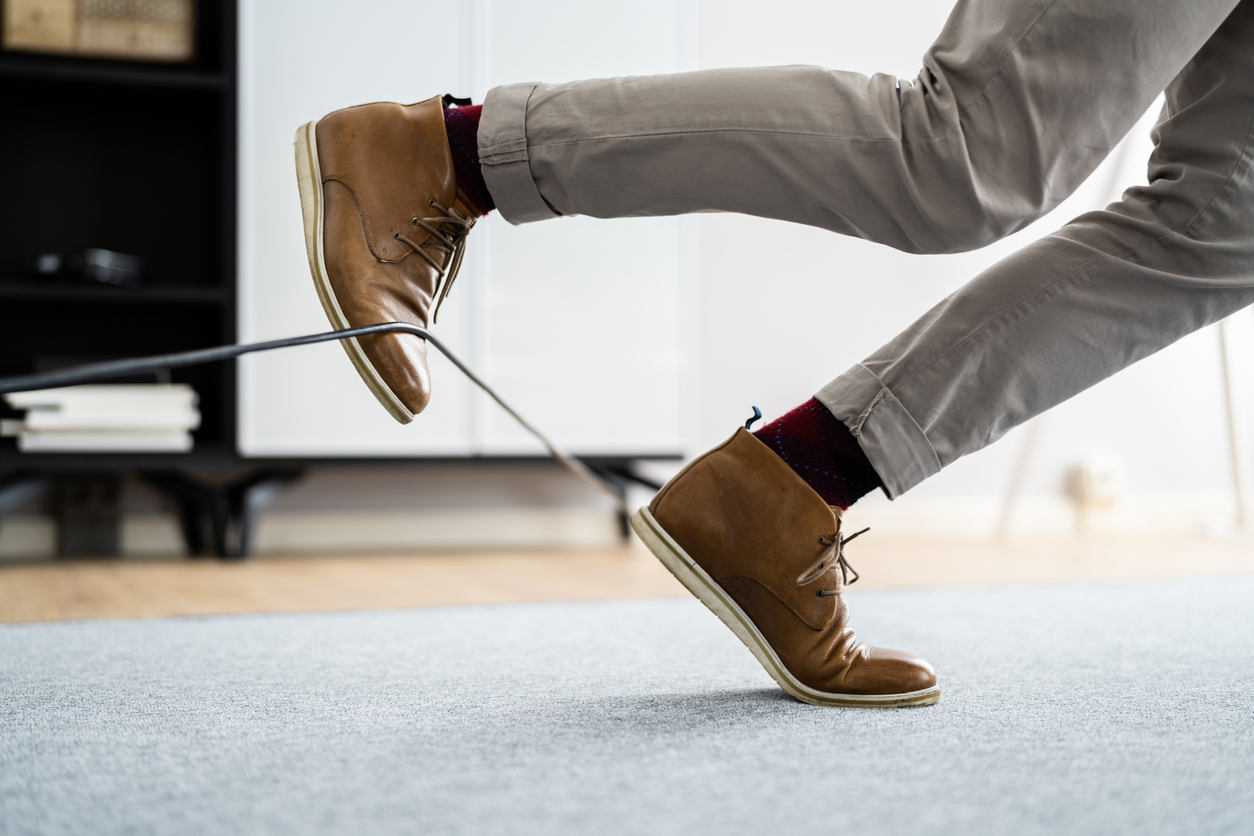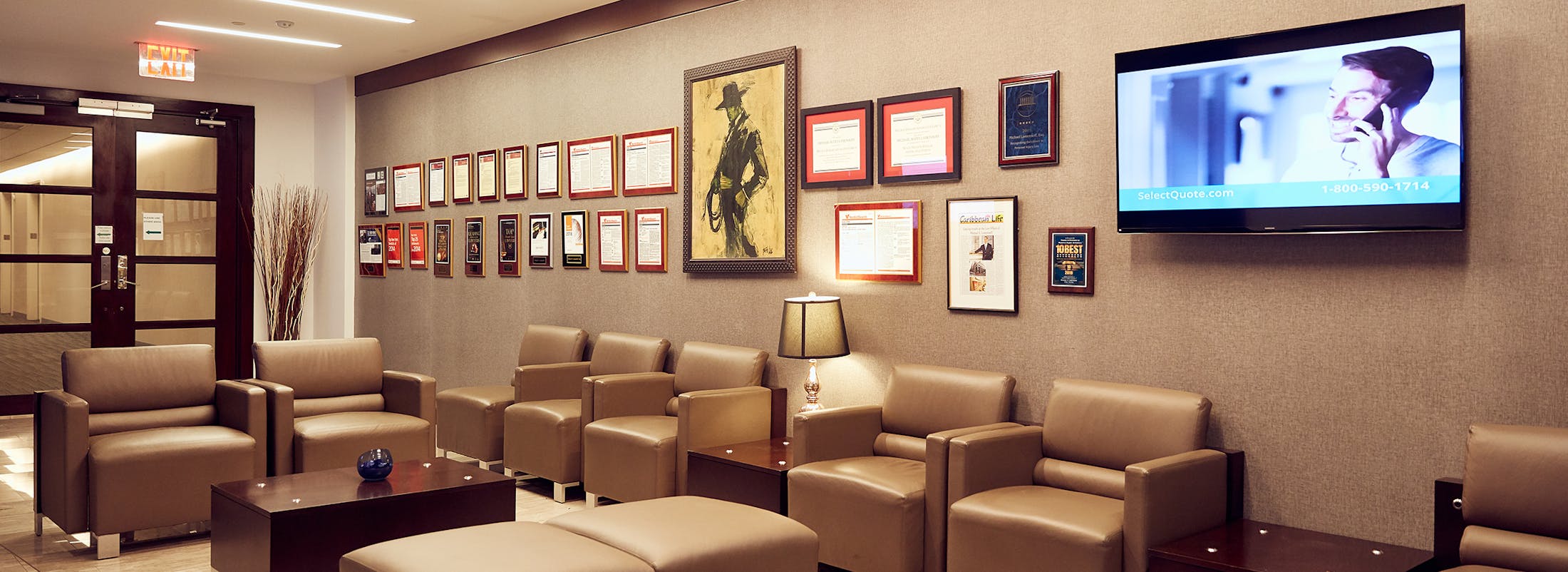Causes of Slip & Fall Accidents
Slip and fall accidents are among the most common premises liability claims in New York, which may result in serious injuries such as broken bones, head trauma, and spinal cord damage. Property owners, landlords, managers, and businesses have a legal obligation to maintain safe premises and address hazards promptly. When they fail to do so, victims may have grounds to seek compensation.

Wet or Slippery Floors
Slippery surfaces are a leading cause of slip and fall accidents, especially in commercial establishments, residential buildings, and public spaces.
- Uncleaned Spills: Liquids such as water, oil, grease, or cleaning solutions that are not promptly cleaned up create hazardous walking conditions. Grocery stores, restaurants, and shopping malls frequently see such incidents.
- Recently Mopped or Waxed Floors: Property owners must use warning signs when floors are wet from cleaning. Failing to provide adequate notice increases the risk of falls.
- Leaking Pipes or Roofs: Water accumulation from plumbing leaks or roof damage can create puddles that become slip hazards, particularly in apartment buildings and office complexes.
- Ice or Snow Accumulation Indoors: During winter months, melted snow and ice tracked into entryways of businesses or residential buildings can create dangerously slippery floors if not managed with mats or warning signs.
Uneven or Damaged Walking Surfaces
Defective flooring, sidewalks, or pavements are a major cause of slip and fall incidents, particularly in older buildings and outdoor spaces.
- Cracked or Uneven Sidewalks: In New York, property owners—including the city in certain cases—are responsible for maintaining sidewalks in front of their properties. Cracks, holes, and sudden elevation changes create tripping hazards.
- Loose Carpeting or Floor Tiles: Torn carpets, unsecured rugs, and broken floor tiles can shift unexpectedly underfoot, causing individuals to lose their balance.
- Potholes in Parking Lots: Poorly maintained parking lots with potholes or eroded surfaces are particularly hazardous, especially for individuals carrying heavy items or walking at night.
- Defective Staircases: Steps that are broken, uneven, or lack proper nosing can lead to dangerous falls, particularly when railings are also missing or unstable.
Poor Lighting Conditions
Proper lighting is essential for visibility and safe navigation of pathways, hallways, and staircases.
- Dimly Lit Stairwells and Hallways: Inadequate lighting in stairwells, apartment corridors, or parking garages makes it difficult for individuals to identify hazards. Landlords and property managers have a duty to ensure common areas are well-lit.
- Burned-Out Light Bulbs: Failing to replace burned-out bulbs in key areas, such as entrances and sidewalks, creates unnecessary dangers for pedestrians.
- Outdoor Pathway Visibility Issues: Poorly lit walkways and driveways increase the likelihood of missteps and falls, especially in areas with uneven terrain or obstacles.
Obstacles and Cluttered Walkways
Blocked walkways and misplaced objects can lead to unexpected falls, especially in busy commercial settings.
- Cords and Electrical Wires: Extension cords running across hallways, office spaces, or store aisles pose a tripping hazard if not properly secured.
- Boxes and Merchandise in Store Aisles: Retail stores have a responsibility to keep aisles clear of debris and stacked items to prevent customers from tripping.
- Construction Debris: Active construction zones or building renovations must have clearly marked warning signs to alert pedestrians of potential trip hazards.
Lack of Handrails or Guardrails
Handrails provide necessary support for individuals using stairs, ramps, or elevated walkways.
- Missing or Loose Handrails: Property owners must ensure staircases and ramps have sturdy handrails. A missing or unstable handrail increases the risk of a serious fall.
- Lack of Guardrails on Elevated Platforms: Outdoor patios, balconies, or open stairwells without protective guardrails create a dangerous fall risk.
- Improperly Installed or Weak Handrails: Handrails that are too low, too high, or not securely fastened may fail when someone relies on them for support, leading to falls and severe injuries.
Unsafe Staircases and Steps
Poorly maintained staircases significantly increase the risk of slip and fall accidents.
- Worn or Slippery Steps: Steps with worn-out surfaces, particularly those made of wood or polished stone, can become dangerously slick without proper traction strips.
- Irregular Step Heights or Depths: Stairs that are not built to uniform code standards can cause individuals to misstep and lose balance.
- Objects Left on Stairs: Cluttered stairwells, such as misplaced shoes, tools, or debris, create unnecessary tripping hazards.
- Inadequate Stair Markings: Steps that blend together without contrast markings or edge visibility increase the likelihood of misjudging a step, particularly in dim lighting.
Defective or Missing Floor Mats
Floor mats are essential for reducing slip risks, particularly in high-traffic areas.
- Lack of Non-Slip Mats in Wet Areas: Entrances to buildings, restaurants, and supermarkets should have absorbent, non-slip mats to prevent floors from becoming dangerously slick.
- Wrinkled or Bunched-Up Mats: Loose or improperly placed floor mats can cause individuals to trip if the edges curl up or fold over.
- Mats Without Proper Grip: Floor mats that slide or shift when stepped on create an unexpected slipping hazard.
- Mats That Become Saturated with Water: When mats become overly wet without being replaced or dried, they lose their effectiveness and can contribute to falls rather than prevent them.
Faulty Drainage Systems
Poor drainage systems can lead to water accumulation and hazardous conditions in both indoor and outdoor areas.
- Standing Water in Parking Lots: Improper drainage in parking garages or lots can lead to puddles, which become even more dangerous during freezing temperatures.
- Water Buildup on Sidewalks and Walkways: Defective drainage systems can cause rainwater to pool in pedestrian areas, increasing the risk of slipping.
- Clogged or Overflowing Gutters: Poorly maintained gutters can lead to water dripping onto walkways, creating wet and slippery conditions.
- Leaking HVAC Systems: Indoor air conditioning units or refrigeration systems that drip onto floors can create slip hazards if not properly maintained.
Hazardous Escalators and Elevators
Poorly maintained escalators and elevators present serious dangers, particularly in high-rise buildings and commercial spaces.
- Slippery Escalator Steps: Escalator treads that become slick due to spills or wear can lead to unexpected falls.
- Abrupt or Jerky Movements: Sudden stops or uneven motion in elevators can cause passengers to lose their balance.
- Misaligned Elevator Floors: When an elevator does not align properly with the floor level, it creates a tripping hazard for individuals entering or exiting.
- Lack of Warning Signs During Maintenance: Property owners must clearly mark escalators or elevators that are out of order to prevent unsafe usage.
Weather-Related Hazards
New York’s harsh winters and unpredictable weather conditions contribute to many slip and fall accidents.
- Icy or Snow-Covered Walkways: Property owners are required to clear snow and ice from sidewalks and entryways within a reasonable time after a storm. Failure to do so creates a liability risk.
- Unshoveled Building Entrances: Businesses and apartment buildings must ensure their entryways remain safe for residents, tenants, and visitors by removing accumulated snow or ice.
- Improper Use of Salt or Sand: While de-icing materials can help prevent slips, unevenly applied salt or sand may create additional hazards if not properly managed.
Maximize Your Compensation with New York’s Top-Rated Slip and Fall Injury Lawyer
If you or a loved one has been injured in a slip and fall accident in New York City, you need a relentless fighter on your side. Michael S. Lamonsoff, widely known as "The Bull," has built a top legal team committed to holding negligent property owners accountable for the highest possible damages.
With over 150 years of combined litigation experience, more than $500 million recovered in settlements and verdicts, and 1,400+ five-star reviews, the Law Offices of Michael S. Lamonsoff, PLLC is the firm you can trust. Michael’s no-nonsense, aggressive representation has earned him national recognition and the respect of both clients and the legal community.
To schedule your free consultation, call us at 212-962-1020 or fill out this online contact form.

